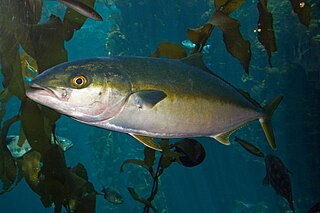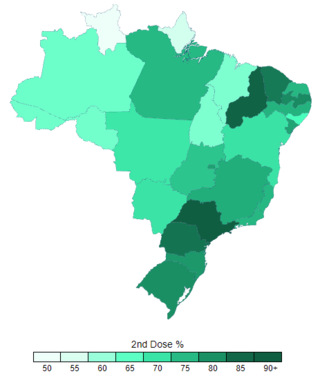
São Paulo is one of the 26 states of the Federative Republic of Brazil and is named after Saint Paul of Tarsus. It is located in the Southeast Region and is limited by the states of Minas Gerais to the north and northeast, Paraná to the south, Rio de Janeiro to the east and Mato Grosso do Sul to the west, in addition to the Atlantic Ocean to the southeast. It is divided into 645 municipalities and its total area is 248,219.481 square kilometres km², which is equivalent to 2.9% of Brazil's surface, being slightly larger than the United Kingdom. Its capital is the municipality of São Paulo.

Rhabdomyolysis is a condition in which damaged skeletal muscle breaks down rapidly, often due to high intensity exercise over a short period of time. Symptoms may include muscle pains, weakness, vomiting, and confusion. There may be tea-colored urine or an irregular heartbeat. Some of the muscle breakdown products, such as the protein myoglobin, are harmful to the kidneys and can cause acute kidney injury.

The yellowtail amberjack, yellowtail kingfish, hiramasa or great amberjack is a large fish found in the Southern Ocean. Although previously thought to be found in all oceans and seas, recent genetic analysis restricts S. lalandi proper to the Southern Hemisphere waters. However, they are found in Northern Hemisphere waters during certain times of the year. The fish was given its name by Monsieur de Lalande, a naturalist who first informed zoologist Achille Valenciennes of the existence of this species. His reason for the use of the word Seriola to name the fish is uncertain, but the second word lalandi was derived from his surname.

Tricholoma equestre or Tricholoma flavovirens, commonly known as the man on horseback or yellow knight is a widely eaten but arguably toxic fungus of the genus Tricholoma that forms ectomycorrhiza with pine trees.

The longfin yellowtail, also known as the almaco or silvercoat jack, deep-water, falcate, European or highfin amberjack, rock salmon, longfin or yellow kingfish, is a game fish of the family Carangidae; they are in the same family as yellowtail and amberjack. They are carnivorous and feed, both day and night, on other, smaller fish, such as baitfish, small squid, octopus, crab and shrimp. The flesh is thick and dense, like tuna, and easily may be passed off for white albacore if prepared as sushi.
Brazilian hemorrhagic fever (BzHF) is an infectious disease caused by Brazilian mammarenavirus, an arenavirus. Brazilian mammarenavirus is one of the arenaviruses from South America to cause hemorrhagic fever. It shares a common progenitor with Argentinian mammarenavirus, Machupo mammarenavirus, Tacaribe mammarenavirus, and Guanarito mammarenavirus. It is an enveloped RNA virus and is highly infectious and lethal. Very little is known about this disease, but it is thought to be transmitted by the excreta of rodents. This virus has also been implicated as a means for bioterrorism, as it can be spread through aerosols.
The 2009 season was Santos Futebol Clube's ninety-seventh season in existence and the club's fifty consecutive season in the top flight of Brazilian football.
The 2008 season was Santos Futebol Clube's ninety-sixth in existence and the club's forty-ninth consecutive season in the top flight of Brazilian football.
The 2013 season is Santos FC's 101st season in existence and the club's fifty-fourth consecutive season in the top flight of Brazilian football.

Trachurus lathami is a species of fish in the family Carangidae and the genus Trachurus, the jack mackerels. Common names include rough scad and horse mackerel in English, as well as chinchard frappeur (French), chicharro garretón (Spanish), jurel, and carapau, garaçuma, surel, and xixarro. It is native to parts of the western Atlantic Ocean, including seas off the eastern coasts of North and South America and the Gulf of Mexico.
Exertional rhabdomyolysis (ER) is the breakdown of muscle from extreme physical exertion. It is one of many types of rhabdomyolysis that can occur, and because of this, the exact prevalence and incidence are unclear.

Events in the year 2016 in Brazil:

Rodrigo Gomes dos Santos, commonly known as Rodrigão, is a Brazilian footballer who plays as a striker.
Rodolpho Theodor Wilhelm Gaspar von Ihering was a Brazilian zoologist and biologist, who is considered to be one of the founders of Pisciculture in Brazil.

Susana Schnarndorf Ribeiro is a Brazilian Paralympic swimmer. In 2005, after a lengthy triathlon career, at the age of 37, Schnarndorf began to experience the first symptoms of a mysterious degenerative disease that was later diagnosed as multiple system atrophy (MSA). After a break from professional athletics, Schnarndorf returned to the sports world as a swimmer and is presently a member of the Brazilian Paralympic Swimming Team.

The COVID-19 pandemic in Brazil has resulted in 37,519,960 confirmed cases of COVID-19 and 702,116 deaths. The virus was confirmed to have spread to Brazil on 25 February 2020, when a man from São Paulo who had traveled to Italy tested positive for the virus. The disease had spread to every federative unit of Brazil by 21 March. On 19 June 2020, the country reported its one millionth case and nearly 49,000 reported deaths. One estimate of under-reporting was 22.62% of total reported COVID-19 mortality in 2020.

Snakebite envenomation is considered a public health problem in Latin America, with an estimated 70,000 cases annually, but due to underreporting, these numbers may be even higher.
Jorge Emílio Medauar (1918-2003) was a Brazilian poet and writer. He was born in 1918 in the village of Água Preta do Mucambo, currently a municipality in Uruçuca, in the southern region of Bahia. His parents, Emílio Medauar and Maria Zaidan Medauar, were Arab immigrants. When still young, he moved to São Simão, in the interior of São Paulo with his family. His career as a writer, journalist and publicist began in Rio de Janeiro in 1945. Initially, he worked in two magazines linked to the Brazilian Communist Party (PCB), as secretary at Literatura (1946-1948) and editor at Fundamentos (1948-1955).

The COVID-19 vaccination campaign in Brazil is an ongoing mass immunization campaign for the COVID-19 pandemic in Brazil. It started on January 17, 2021, when the country had 210 thousand deaths.

Events in the year 2022 in Brazil.












